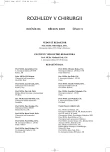Penetrating Thoracic Injury – Seven-Year Experience with its Diagnostics and Treatment
Authors:
J. Vodička 1; V. Špidlen 1; J. Šafránek 1; V. Šimánek 1; J. Klečka 1; P. Altmann 2; J. Ferda 3
Authors‘ workplace:
Chirurgická klinika Fakultní nemocnice v Plzni, přednosta: prof. MUDr. V. Třeška, DrSc.
1; Anesteziologicko-resuscitační klinika Fakultní nemocnice v Plzni, přednosta: doc. MUDr. E. Kasal, CSc.
2; Radiodiagnostická klinika Fakultní nemocnice v Plzni, přednosta: doc. MUDr. B. Kreuzberg, CSc.
3
Published in:
Rozhl. Chir., 2007, roč. 86, č. 3, s. 120-125.
Category:
Monothematic special - Original
Overview
Aim of the study:
A retrospective analysis of seven-year follow-up results of subjects treated for penetrating thoracic injuries, aimed at optimalizing the diagnostic-therapeutic algorithm.
Material and Methodology:
During 2000–2006, 39 subjects with penetrating thoracic injuries (35 males and 4 females, their mean age was 40.5 years), were diagnosed and treated in the authors’ clinic. Cold weapon attacks were the commonest mechanism of the injuries (54%). The injury resulted in pneumothorax, resp. hemothorax, in, nearly, half of the subjects. The mean ISS value in the study group was 23. Less than a third of the injuried suffered associated injuries of the neck or abdominal regions. The diagnostics was based on clinical and x-ray examinations, resp. on thoracic CT.
Results:
The commonest therapeutic procedure was draining of the pleural cavity (17 subjects). In 36% of the subjects, surgical revision via thoracotomy, resp. sternotomy, was inevitable. In two subjects, miniinvasive approach sufficed. Four subjects were treated conservatively. Two patients exited immediately following their transport to hospital, no therapeutic management was possible. No other deaths following the treatment were recorded, postoperative complications occurred in 4 subjects (10%), and they, equally, required 4 reoperations.
Conclusion:
The diagnostic process of penetrating thoracic traumas is based on clinical examination and x-ray, resp. thoracic CT. Most injuries are sufficiently managed using good quality drainage of the pleural cavity. Only few cases require urgent surgical revision via thoracotomy or sternotomy. Selected cases, mainly including stab injuries, may be successfully treated using miniinvasive techniques.
Key words:
penetrating thoracic injuries – diagnostics – thoracic drainage – thoracotomy – videothoracoscopy
Sources
1. Obretenov, E., Karakolev, Ž., Penkov, P., Andreev, A. Kombinovaná poranění srdce. Rozhl. Chir., 1994, roč. 73, č. 2, s. 75–77.
2. Potaris, K., Mihos, P., Gakidis, I. Role of video-assisted thoracic surgery in the evaluation and management of thoracic injuries. Interact. CardioVasc. Thorac. Surg., 2005, roč. 4, č. 4, s. 292–294.
3. Hájek, M. Traumatologie hrudníku. Praha: Avicenum, 1980, 240 s.
4. Demeš, R., Čermák, S., Výborný, J., Pešková, M., Zeman, M., Krška, Z., Rehák, M., Trča, S., Paul, O. Videotorakoskopie a videoasistované chirurgické výkony u penetrujících poranění hrudníku. Rozhl. Chir., 2001, roč. 80, č. 6, s. 304–307.
5. Melichar, V., Vrastyák, J. Naše zkušenosti s miniinvazivním ošetřením otevřeného poranění hrudníku. Miniinvazívna chirurgia a endoskopia, 2005, roč. 9, č. 1, s. 14–18.
6. Vyhnánek, F., Strnad, J., Vojtíšek, O., Pelák, Z. Bodná a střelná poranění torakoabdominální. Rozhl. Chir., 1993, roč. 72, č. 6, s. 242–245.
7. Špidlen, V., Vodička, J., Klečka, J. Bodné poranění srdce. Rozhl. Chir., 2002, roč. 81, č. 9, s. 439–442.
8. Yanar, H., Aksoy, M., Taviloglu, K., Unal, E. S., Kurtoglu, M., Nisli, K. Trans-sternal cardiac injury caused by a hooked needle. Emerg. Med. J., 2005, roč. 22, č. 10, s. 751–753.
9. Černý, J. Špeciálna chirurgia - 3 Chirurgia hrudníka. Martin: Osveta, 1993, 375 s.
10. Manlulu, A. V., Lee, T. W., Thung, K. H., Wong, R., Yim, A. P. C. Current indications and results of VATS in the evaluation and management of hemodynamically stable thoracic injurie. Eur. J. Cardiothorac. Surg., 2004, roč. 25, č. 6, s. 1048–1053.
11. Gibbons, J. R. Treatment of missile injuries of the chest: Belfast experience. Eur. J. Cardiothorac. Surg., 1989, roč. 3, č. 4, s. 297–299.
12. Harris, D. G., Janson, J.T., van Wyk, J., Pretorius, J., Rossouw, G. J. Delayed pericardial effusion following stab wounds to the chest. Eur. J. Cardiothorac. Surg., 2003, roč. 23, č. 4, s. 473–476.
13. Ferda, J. Současné trendy v zobrazování výpočetní tomografií. Lék. listy, 2004, č. 51–52, s. 25–26.
14. Lardinois, D., Sippel, M., Gugger, M., Dusmet, M., Ris, H. B. Morbidity and validity of the hemiclamshell approach for thoracic surgery. Eur. J. Cardiothorac. Surg., 1999, roč. 16, č. 2, s. 194–199.
15. Mineo, T. C., Ambrogi, V., Cristino, B., Pompeo, E., Pistolese, C. Changing indications for thoracotomy in blunt chest trauma after the advent of videothoracoscopy. J. Trauma, 1999, roč. 47, č. 6, s. 1088–1091.
16. Ochmann, J., Vrastyák, J., Svoboda, P., Kantorová, I., Zelníček, P., Čierny, M. Trauma a časná torakoskopie. Rozhl. Chir., 1996, roč. 75, č. 8, s. 386–389.
17. Pons, F., Lang-Lazdunski, L., de Kerangal, X., Chapuis, O., Bonnet, P. M., Jancovici, R. The role of videothoracoscopy in management of precordial thoracic penetrating injuries. Eur. J. Cardiothorac. Surg., 2002, roč. 22, č. 1, s. 7–12.
18. Hanvesakul, R., Momin, A., Gee, M. J., Marrinan, M. T. A role for video assisted thoracoscopy in stable penetrating chest trauma. Emerg. Med. J., 2005, roč. 22, č. 5, s. 386-387.
Labels
Surgery Orthopaedics Trauma surgeryArticle was published in
Perspectives in Surgery

2007 Issue 3
Most read in this issue
- Lung Sequestration as an Accidental Finding in Adulthood. Surgical Therapy
- Partial Mastectomy vs. Breast Ablation in Treatment of Invasive Lobulary Carcinoma
- Reconstruction of Soft Tissue Defects of Lower Leg, Ankle and Foot using Sural Flap
- Crossectomy Doesn’t Improve Outcome of Endovenous Laser Ablation of Varicose Veins
